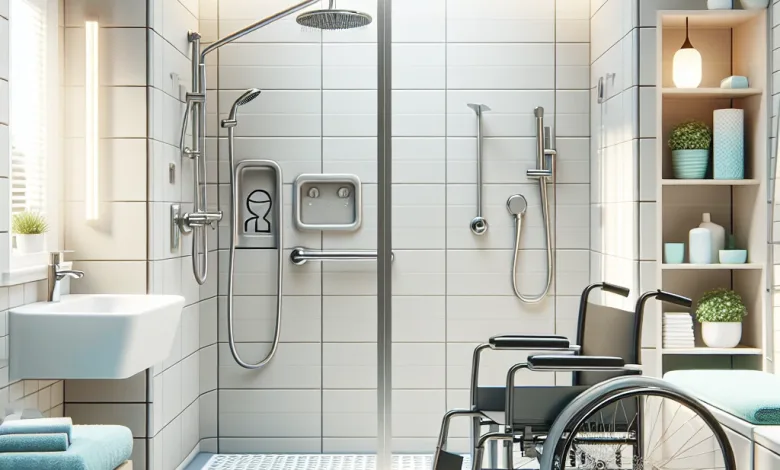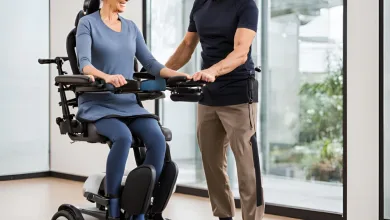Transforming Bath Time: Essential Bathing Aids for Wheelchair Users

Table of Contents
Discover Comfort and Independence in Your Bathroom Routine
Are you or a loved one navigating the challenges of bathing with mobility issues? You’re not alone. Many wheelchair users face daily hurdles in the bathroom, but there’s good news: a world of innovative and essential bathing aids for wheelchair users is waiting to transform your experience. Let’s dive into the solutions to make bath time safer, more comfortable, and enjoyable!
Why Bathing Aids Matter
Imagine starting your day with a refreshing shower, feeling clean and confident, all without the stress of safety concerns or the need for constant assistance. That’s the power of well-designed wheelchair-accessible bathing equipment. These tools aren’t just about cleanliness but dignity, independence, and quality of life.
Navigating the World of Bathing Solutions
1. Shower Chairs: Your Throne of Comfort
Shower aids for wheelchair users come in many forms, but shower chairs are the true MVPs. These sturdy seats provide a stable base for bathing, allowing you to relax and focus on getting clean.
– Pros:
– Increased safety
– Comfort during long showers
– Adjustable heights for personalized use
– Cons:
– May require some storage space
– Initial cost can be higher for premium models
2. Transfer Benches: Bridging the Gap
Transfer benches are game-changers for disabled individuals. These benches extend beyond the tub’s edge, creating a smooth transition from wheelchair to bathtub.
– Pros:
– Reduces fall risk during transfers
– Suitable for various bathroom layouts
– Often foldable for easy storage
– Cons:
– May require assistance for setup
– Can be bulky in smaller bathrooms
3. Bath Lifts: Elevating Your Bathing Experience
For those who love a good soak, bath lifts for wheelchair users offer a way to enjoy a tub bath safely. These devices gently lower you into the water and raise you back up when you’re done.
– Pros:
– Allows for full-body immersion
– Battery-operated for convenience
– Suitable for various tub sizes
– Cons:
– Higher price point
– May require professional installation
4. Handheld Showerheads: Flexibility at Your Fingertips
While not exclusively for wheelchair users, handheld showerheads are essential bathing tools for people with disabilities. They bring the water to you, making rinsing a breeze.
– Pros:
– Easy to direct water flow
– Useful for seated bathing
– Often includes multiple spray settings
– Cons:
– May need assistance to install
– Hose can be a tripping hazard if not properly managed
5. Non-Slip Mats: The Unsung Heroes
Remember the importance of an excellent non-slip mat. These simple bath safety products for wheelchair users can prevent dangerous slips and falls.
– Pros:
– Affordable
– Easy to install and clean
– Provides peace of mind
– Cons:
– Needs regular cleaning to maintain effectiveness
– May not be suitable for all surface types
Choosing the Right Aids for You
Selecting the perfect bathing products for disabled individuals isn’t a one-size-fits-all process. Consider these factors:
1. Your specific mobility needs: What tasks are most challenging?
2. Bathroom layout: Measure your space to ensure a good fit.
3. Budget: Many aids are investments in your long-term well-being.
4. Ease of use: Will you need assistance or use the aid independently?
Beyond the Basics: Innovative Solutions
The world of adapted bathing equipment for wheelchairs is constantly evolving. Here are some cutting-edge options to consider:
Smart Shower Systems
Imagine controlling water temperature and flow with voice commands. Intelligent shower systems are making this a reality, offering unprecedented independence for many users.
Inflatable Bathing Cushions
These portable aids provide comfort and support in unfamiliar bathrooms, perfect for travellers or those who split time between homes.
Ceiling Track Hoists
For those with more complex mobility needs, ceiling track hoists offer smooth transfers from bed to bath and beyond.
Creating Your Accessible Oasis
Transforming your bathroom into a wheelchair-friendly space goes beyond just adding equipment. Consider these tips:
1. Widen doorways for easy access
2. Install lever-style faucets for more effortless operation
3. Lower mirrors and counters for seated use
4. Opt for a roll-in shower design if renovating
The Impact of Proper Bathing Aids
Investing in the right bathing solutions for mobility issues can profoundly affect your daily life. Users report:
– Increased confidence and independence
– Reduced risk of injury
– More enjoyment in personal care routines
– Less strain on caregivers
Navigating Insurance and Funding
Quality handicap bathing aids can be a significant investment. Here’s how to make them more accessible:
1. Check with your insurance provider about coverage for disability-friendly bath aids
2. Explore government assistance programs for home modifications
3. Look into local non-profit organizations that may offer financial support
4. Consider rental options for temporary needs
Maintenance: Keeping Your Aids in Top Shape
To ensure your wheelchair-friendly shower chairs and other equipment last, follow these tips:
1. Clean regularly with non-abrasive cleaners
2. Check for wear and tear, especially on non-slip surfaces
3. Tighten any loose screws or fittings promptly
4. Replace batteries in electronic aids as needed
Real Stories: How Bathing Aids Change Lives
Meet Sarah, a 35-year-old wheelchair user who rediscovered her love for bubble baths thanks to a bath lift. “I hadn’t taken a proper bath in years,” she shares. “Now, it’s my favorite part of the week. I feel like myself again.”
Or consider Tom, whose fear of falling made showering a daily ordeal. He says, “I can take my time and enjoy getting clean with a sturdy shower chair and handheld showerhead. It’s not a chore anymore; it’s refreshing.”
Looking to the Future: Innovations on the Horizon
The field of accessible bathroom products is ripe for innovation. Keep an eye out for:
1. VR-assisted bathroom planning tools
2. 3D-printed custom bath aids
3. Robotic assistance devices
4. Self-cleaning surfaces for easier maintenance
Making the Transition: Tips for New Users
If you’re new to using bathing assistance devices for wheelchairs, here are some tips to ease the transition:
1. Start slowly, allowing time to adjust to new routines
2. Don’t hesitate to ask for help or demonstrations
3. Be patient with yourself as you learn
4. Celebrate the small victories in your journey to independence
Beyond Bathing: Comprehensive Bathroom Accessibility
While we’ve focused on bathing, remember that proper bathroom safety for disabled individuals encompasses the entire space. Consider these additional modifications:
1. Raised toilet seats with grab bars
2. Accessible storage solutions
3. Good lighting for safety
4. Non-slip flooring throughout
The Environmental Angle: Eco-Friendly Bathing Aids
For the environmentally conscious, look for bathing aids for wheelchair users made from sustainable materials or designed for longevity. Some companies now offer recycling programs for old equipment.
Traveling with Confidence: Portable Bathing Solutions
Don’t let travel plans intimidate you. Many bathing mobility aids are designed with portability in mind. Collapsible shower chairs, inflatable cushions, and suction-cup grab bars can make any bathroom more accessible.
Customization: Tailoring Aids to Your Needs
Remember, many bathing products for disabled individuals can be customized. Contact manufacturers about modifications that could make their products perfect for your unique situation.
The Role of Technology in Modern Bathing Aids
From app-controlled bath lifts to intelligent sensors that detect slips, technology is revolutionizing accessible bathing for disabled individuals. Embrace these advancements to enhance your bathing experience further.
Community Resources: You’re Not Alone
Connect with others who use bathing aids for wheelchair users through online forums, support groups, or local organizations. Sharing experiences and tips can be invaluable as you navigate this journey.
Conclusion: Embrace a New Era of Bathing
With suitable wheelchair-accessible bathing equipment, bath time can transform from a challenge into a pleasure. Remember, investing in these aids is an investment in your quality of life, independence, and well-being.
Don’t let mobility issues hold you back from enjoying a refreshing shower or a relaxing bath. Explore the world of bathing aids for wheelchair users and find the best solutions for you. Your perfect bathing experience awaits!
FAQs: Your Burning Questions Answered
- Q: Are bathing aids covered by insurance?
- A: Coverage varies by provider and policy. Check with your insurance company for specifics. Some plans may cover essential aids as part of home modification or durable medical equipment benefits.
- Q: How do I know which bathing aid is right for me?
- A: Consider your specific needs, bathroom layout, and budget. Consulting with an occupational therapist can provide personalized recommendations based on your mobility challenges and preferences.
- Q: Can I install bathing aids myself?
- A: While some aids, like non-slip mats and handheld showerheads, are DIY-friendly, others, like bath lifts and ceiling track hoists, may require professional installation to ensure safety and proper functionality.
- Q: How often should I replace my bathing aids?
- A: Bathing aids’ lifespan depends on usage and wear. It is crucial to inspect them regularly for damage and decreased effectiveness. Replace them if you notice any issues to maintain safety.
- Q: Are there waterproof options for electric wheelchair users?
- A: Many manufacturers offer waterproof or water-resistant options explicitly designed for shower use. Ensure that any electric components are certified for bathroom safety.
- Q: What are some cost-effective bathing aids?
- A: Non-slip mats, handheld showerheads, and basic shower chairs are generally affordable and can significantly enhance bathroom safety. For more advanced aids, consider rental options or explore financial assistance programs.
- Q: How can I make my bathroom more accessible?
- A: Beyond using bathing aids, consider modifications like widening doorways, installing lever-style faucets, lowering mirrors and counters for seated use, and opting for a roll-in shower design if renovating.
- Q: What should I look for in a shower chair?
- A: Look for features such as adjustable height, sturdy construction, non-slip feet, and easy-to-clean materials. Comfort and stability are vital to ensuring a safe and pleasant bathing experience.
- Q: Can I travel with my bathing aids?
- A: Many bathing mobility aids are designed for portability. Look for collapsible shower chairs, inflatable cushions, and suction-cup grab bars that you can easily pack and use in various locations.
- Q: How do I maintain my bathing aids?
- A: Clean your aids regularly with non-abrasive cleaners, check for wear and tear, tighten any loose screws or fittings promptly, and replace batteries in electronic aids as needed to ensure longevity and reliability.
- Q: Are there eco-friendly bathing aids available?
- A: For environmentally conscious users, some bathing aids are made from sustainable materials and designed for longevity. Additionally, some companies offer recycling programs for old equipment, promoting eco-friendly practices.
- Q: What innovative solutions are available for complex mobility needs?
- A: Cutting-edge options like smart shower systems, ceiling track hoists, and inflatable bathing cushions provide enhanced support and independence for users with complex mobility needs. These solutions are continually evolving to offer better functionality and ease of use.
Remember, your journey to comfortable, safe bathing is unique. Don’t hesitate to ask questions, seek professional advice, and explore the wide world of bathing aids for wheelchair users. Here’s to many refreshing, relaxing, and rejuvenating baths in your future!



